Initial management of the acute reaction is usually based entirely on history, exam findings, and clinical suspicion. Any indication of anaphylaxis should prompt immediate supportive care, as loss of airway patency and cardiovascular collapse may occur rapidly. Stabilization and treatment of life-threatening conditions are most often performed simultaneously. All patients with signs of a systemic reaction, especially hypotension, airway swelling, or difficulty breathing, should receive immediate intramuscular epinephrine (adrenaline) in the anterolateral thigh.[42]Sicherer SH, Simons FE. Epinephrine for first-aid management of anaphylaxis. Pediatrics. 2017 Mar;139(3).
http://pediatrics.aappublications.org/content/139/3/e20164006.long
http://www.ncbi.nlm.nih.gov/pubmed/28193791?tool=bestpractice.com
[43]Singletary EM, Charlton NP, Epstein JL, et al. Part 15: first aid: 2015 American Heart Association and American Red Cross guidelines update for first aid. Circulation. 2015 Nov 3;132(18 suppl 2):S574-89.
http://circ.ahajournals.org/content/132/18_suppl_2/S574.long
http://www.ncbi.nlm.nih.gov/pubmed/26473003?tool=bestpractice.com
[44]Dinakar C. Anaphylaxis in children: current understanding and key issues in diagnosis and treatment. Curr Allergy Asthma Rep. 2012 Dec;12(6):641-9.
https://www.ncbi.nlm.nih.gov/pmc/articles/PMC3492692
http://www.ncbi.nlm.nih.gov/pubmed/22815131?tool=bestpractice.com
[45]Sicherer SH, Leung DY. Advances in allergic skin disease, anaphylaxis, and hypersensitivity reactions to foods, drugs, and insects in 2014. J Allergy Clin Immunol. 2015 Feb;135(2):357-67.
http://www.ncbi.nlm.nih.gov/pubmed/25662305?tool=bestpractice.com
[46]Sheikh A, Simons FE, Barbour V, et al. Adrenaline auto-injectors for the treatment of anaphylaxis with and without cardiovascular collapse in the community. Cochrane Database Syst Rev. 2012 Aug 15;(8):CD008935.
https://www.cochranelibrary.com/cdsr/doi/10.1002/14651858.CD008935.pub2/full
http://www.ncbi.nlm.nih.gov/pubmed/22895980?tool=bestpractice.com
Close monitoring is still necessary in less severe reactions (or reactions responding to treatment), as rapid deterioration or rebound from treatment is possible.[3]Golden DBK, Wang J, Waserman S, et al. Anaphylaxis: a 2023 practice parameter update. Ann Allergy Asthma Immunol. 2024 Feb;132(2):124-76.
https://www.annallergy.org/article/S1081-1206(23)01304-2/fulltext
http://www.ncbi.nlm.nih.gov/pubmed/38108678?tool=bestpractice.com
[28]Resuscitation Council UK. Emergency treatment of anaphylactic reactions: guidelines for healthcare providers. 2021 [internet publication].
https://www.resus.org.uk/library/2021-resuscitation-guidelines
[47]Clark S, Camargo CA Jr. Emergency treatment and prevention of insect sting anaphylaxis. Curr Opin Allergy Clin Immunol. 2006 Aug;6(4):279-83.
http://www.ncbi.nlm.nih.gov/pubmed/16825869?tool=bestpractice.com
Patients with biphasic reactions or severe reactions that have not responded well to treatment may require prolonged observation in the emergency room (ER).[3]Golden DBK, Wang J, Waserman S, et al. Anaphylaxis: a 2023 practice parameter update. Ann Allergy Asthma Immunol. 2024 Feb;132(2):124-76.
https://www.annallergy.org/article/S1081-1206(23)01304-2/fulltext
http://www.ncbi.nlm.nih.gov/pubmed/38108678?tool=bestpractice.com
Any return of symptoms should lead to retreatment and may indicate a need for hospital admission. Regardless of severity, all patients with a diagnosis of anaphylaxis should be kept under observation until signs and symptoms have fully resolved.[2]Shaker MS, Wallace DV, Golden DBK, et al. Anaphylaxis - a 2020 practice parameter update, systematic review, and Grading of Recommendations, Assessment, Development and Evaluation (GRADE) analysis. J Allergy Clin Immunol. 2020 Apr;145(4):1082-123.
https://www.jacionline.org/article/S0091-6749(20)30105-6/fulltext
http://www.ncbi.nlm.nih.gov/pubmed/32001253?tool=bestpractice.com
Coexisting cardiovascular disease should be noted because some treatments can stress a susceptible heart.[48]Pumphrey RS. Lessons for management of anaphylaxis from a study of fatal reactions. Clin Exp Allergy. 2000 Aug;30(8):1144-50.
http://www.ncbi.nlm.nih.gov/pubmed/10931122?tool=bestpractice.com
Caution and close monitoring should be used when treating these patients. However, pre-existing heart disease is not a contraindication to treatment of suspected anaphylactic reactions.
Cardiopulmonary arrest
If the patient is in cardiopulmonary arrest, cardiopulmonary resuscitation with intubation and ventilation, intravenous fluid replacement, and intravenous epinephrine are indicated.[49]Brown SG. Cardiovascular aspects of anaphylaxis: implications for treatment and diagnosis. Curr Opin Allergy Clin Immunol. 2005 Aug;5(4):359-64.
http://www.ncbi.nlm.nih.gov/pubmed/15985820?tool=bestpractice.com
See also Anaphylaxis.
Systemic reactions
It is important to remember to reevaluate the patient frequently as their condition may deteriorate quickly.
Primary airway, breathing, and circulation assessment: abnormalities in any of these aspects signal the need for immediate intervention (immediate treatment and preparation for transfer to ER or advanced care setting):
Airway patency and ability to maintain airway
Evidence of tongue or throat swelling
Swallowing of own secretions or the presence of drooling
Problems with spontaneous breathing, dyspnea, wheeze, cough, air hunger
Palpable pulses, pulse rate, and rhythm
Skin flushing (vasodilated) or skin pallor with clamminess (vasoconstricted)
Positioning: supine (or on side) if hypotensive, but may need to be more upright if severe dyspnea.
Cardiopulmonary assessment and supportive measures
Airway patency must be maintained, as airways can close within minutes when surrounding tissues swell.
Supplemental oxygen should be considered for all patients with anaphylaxis regardless of their respiratory status, and must be administered to any patient with respiratory or cardiovascular compromise and to those who do not respond to initial treatment with epinephrine.[2]Shaker MS, Wallace DV, Golden DBK, et al. Anaphylaxis - a 2020 practice parameter update, systematic review, and Grading of Recommendations, Assessment, Development and Evaluation (GRADE) analysis. J Allergy Clin Immunol. 2020 Apr;145(4):1082-123.
https://www.jacionline.org/article/S0091-6749(20)30105-6/fulltext
http://www.ncbi.nlm.nih.gov/pubmed/32001253?tool=bestpractice.com
Early prophylactic intubation or even cricothyrotomy may be necessary, especially if there is inspiratory stridor.[2]Shaker MS, Wallace DV, Golden DBK, et al. Anaphylaxis - a 2020 practice parameter update, systematic review, and Grading of Recommendations, Assessment, Development and Evaluation (GRADE) analysis. J Allergy Clin Immunol. 2020 Apr;145(4):1082-123.
https://www.jacionline.org/article/S0091-6749(20)30105-6/fulltext
http://www.ncbi.nlm.nih.gov/pubmed/32001253?tool=bestpractice.com
Any subjective findings (e.g., feeling of swelling or tightness in the throat or oropharynx) or objective findings (e.g., stridor, hoarseness, visualized glottic or tongue edema, cyanosis) warrant preparation for emergency airway management.
Cardiovascular collapse should be treated with aggressive volume resuscitation (isotonic solutions, e.g., 0.9% normal saline or Ringer lactate) and vasopressor infusion.
Patients requiring airway support or treatment for cardiovascular collapse must be moved to the ER or critical care setting as rapidly as possible.
Unless precluded by shortness of breath or vomiting, the patient should be placed in a supine position with legs elevated (shock or Trendelenburg position).[49]Brown SG. Cardiovascular aspects of anaphylaxis: implications for treatment and diagnosis. Curr Opin Allergy Clin Immunol. 2005 Aug;5(4):359-64.
http://www.ncbi.nlm.nih.gov/pubmed/15985820?tool=bestpractice.com
This will augment venous return, and thereby increase preload and enhance cardiac output.
Regardless of severity of reaction, all patients with a diagnosis of anaphylaxis should be kept under observation until signs and symptoms have fully resolved, and may require extended observation or admission.[3]Golden DBK, Wang J, Waserman S, et al. Anaphylaxis: a 2023 practice parameter update. Ann Allergy Asthma Immunol. 2024 Feb;132(2):124-76.
https://www.annallergy.org/article/S1081-1206(23)01304-2/fulltext
http://www.ncbi.nlm.nih.gov/pubmed/38108678?tool=bestpractice.com
Any retained stingers should be removed as soon as they are identified.
Epinephrine (adrenaline)
All patients with signs of a systemic reaction, especially hypotension, airway swelling, or difficulty breathing, should receive immediate intramuscular epinephrine in the anterolateral thigh.[42]Sicherer SH, Simons FE. Epinephrine for first-aid management of anaphylaxis. Pediatrics. 2017 Mar;139(3).
http://pediatrics.aappublications.org/content/139/3/e20164006.long
http://www.ncbi.nlm.nih.gov/pubmed/28193791?tool=bestpractice.com
[43]Singletary EM, Charlton NP, Epstein JL, et al. Part 15: first aid: 2015 American Heart Association and American Red Cross guidelines update for first aid. Circulation. 2015 Nov 3;132(18 suppl 2):S574-89.
http://circ.ahajournals.org/content/132/18_suppl_2/S574.long
http://www.ncbi.nlm.nih.gov/pubmed/26473003?tool=bestpractice.com
[44]Dinakar C. Anaphylaxis in children: current understanding and key issues in diagnosis and treatment. Curr Allergy Asthma Rep. 2012 Dec;12(6):641-9.
https://www.ncbi.nlm.nih.gov/pmc/articles/PMC3492692
http://www.ncbi.nlm.nih.gov/pubmed/22815131?tool=bestpractice.com
[45]Sicherer SH, Leung DY. Advances in allergic skin disease, anaphylaxis, and hypersensitivity reactions to foods, drugs, and insects in 2014. J Allergy Clin Immunol. 2015 Feb;135(2):357-67.
http://www.ncbi.nlm.nih.gov/pubmed/25662305?tool=bestpractice.com
[46]Sheikh A, Simons FE, Barbour V, et al. Adrenaline auto-injectors for the treatment of anaphylaxis with and without cardiovascular collapse in the community. Cochrane Database Syst Rev. 2012 Aug 15;(8):CD008935.
https://www.cochranelibrary.com/cdsr/doi/10.1002/14651858.CD008935.pub2/full
http://www.ncbi.nlm.nih.gov/pubmed/22895980?tool=bestpractice.com
The dose may be repeated every 5-15 minutes as needed.[1]Sampson HA, Muñoz-Furlong A, Campbell RL, et al. Second symposium on the definition and management of anaphylaxis: summary report - second National Institute of Allergy and Infectious Disease/Food Allergy and Anaphylaxis Network symposium. J Allergy Clin Immunol. 2006 Feb;117(2):391-7.
http://www.jacionline.org/article/S0091-6749%2805%2902723-5/fulltext
http://www.ncbi.nlm.nih.gov/pubmed/16461139?tool=bestpractice.com
[3]Golden DBK, Wang J, Waserman S, et al. Anaphylaxis: a 2023 practice parameter update. Ann Allergy Asthma Immunol. 2024 Feb;132(2):124-76.
https://www.annallergy.org/article/S1081-1206(23)01304-2/fulltext
http://www.ncbi.nlm.nih.gov/pubmed/38108678?tool=bestpractice.com
Administration in the anterolateral thigh is superior to intramuscular administration in the deltoid or a subcutaneous injection.[50]Simons FE, Gu X, Simons KJ. Epinephrine absorption in adults: intramuscular versus subcutaneous injection. J Allergy Clin Immunol. 2001 Nov;108(5):871-3.
http://www.ncbi.nlm.nih.gov/pubmed/11692118?tool=bestpractice.com
[51]Simons FE, Roberts JR, Gu X, et al. Epinephrine absorption in children with a history of anaphylaxis. J Allergy Clin Immunol. 1998 Jan;101(1 Pt 1):33-7.
http://www.ncbi.nlm.nih.gov/pubmed/9449498?tool=bestpractice.com
Intravenous epinephrine is administered to patients in cardiopulmonary arrest, and to profoundly hypotensive patients who have not responded to intravenous fluids and several doses of intramuscular epinephrine.[2]Shaker MS, Wallace DV, Golden DBK, et al. Anaphylaxis - a 2020 practice parameter update, systematic review, and Grading of Recommendations, Assessment, Development and Evaluation (GRADE) analysis. J Allergy Clin Immunol. 2020 Apr;145(4):1082-123.
https://www.jacionline.org/article/S0091-6749(20)30105-6/fulltext
http://www.ncbi.nlm.nih.gov/pubmed/32001253?tool=bestpractice.com
[52]Muraro A, Roberts G, Worm M, et al. Anaphylaxis: guidelines from the European Academy of Allergy and Clinical Immunology. Allergy. 2014 Aug;69(8):1026-45.
https://onlinelibrary.wiley.com/doi/10.1111/all.12437
http://www.ncbi.nlm.nih.gov/pubmed/24909803?tool=bestpractice.com
Continuous infusion of epinephrine, titrated to effect, is reserved for experienced practitioners. No intravenous dose regimen is universally recognized.
The alpha-1, beta-1, and beta-2 agonist actions of epinephrine play a key role in reversing the effects of anaphylaxis. Stimulation of the alpha-1 receptors leads to increased vascular tone and thus reversal of the effects of massive vasodilation triggered by immune mediators. However, alpha-1 stimulation can also lead to severe hypertension, especially in those with poorly controlled hypertension. Beta-1 receptor stimulation has positive inotropic and chronotropic effects (i.e., the heart rate and contractility are increased), but an overshooting response can result in unwanted tachycardia, potentially harming a patient with coronary artery disease. Beta-2 agonism causes bronchodilation and impairs release of mediators from mast cells and basophils.
A prescription for two epinephrine auto-injectors must be given following any episode of anaphylaxis.[2]Shaker MS, Wallace DV, Golden DBK, et al. Anaphylaxis - a 2020 practice parameter update, systematic review, and Grading of Recommendations, Assessment, Development and Evaluation (GRADE) analysis. J Allergy Clin Immunol. 2020 Apr;145(4):1082-123.
https://www.jacionline.org/article/S0091-6749(20)30105-6/fulltext
http://www.ncbi.nlm.nih.gov/pubmed/32001253?tool=bestpractice.com
[5]Muraro A, Worm M, Alviani C, et al. EAACI guidelines: anaphylaxis (2021 update). Allergy. 2022 Feb;77(2):357-77.
https://onlinelibrary.wiley.com/doi/10.1111/all.15032
http://www.ncbi.nlm.nih.gov/pubmed/34343358?tool=bestpractice.com
[28]Resuscitation Council UK. Emergency treatment of anaphylactic reactions: guidelines for healthcare providers. 2021 [internet publication].
https://www.resus.org.uk/library/2021-resuscitation-guidelines
[53]Medicines and Healthcare products Regulatory Agency. Adrenaline auto-injectors (AAIs): new guidance and resources for safe use. Jun 2023 [internet publication].
https://www.gov.uk/drug-safety-update/adrenaline-auto-injectors-aais-new-guidance-and-resources-for-safe-use
The patient or caregiver should carry both at all times and be familiar with their use.[24]Hewett Brumberg EK, Douma MJ, Alibertis K, et al. 2024 American Heart Association and American Red Cross guidelines for first aid. Circulation. 2024 Nov 14.
https://www.ahajournals.org/doi/abs/10.1161/CIR.0000000000001281
http://www.ncbi.nlm.nih.gov/pubmed/39540278?tool=bestpractice.com
[54]Bilò MB, Cichocka-Jarosz E, Pumphrey R, et al. Self-medication of anaphylactic reactions due to Hymenoptera stings: an EAACI task force consensus statement. Allergy. 2016 Jul;71(7):931-43.
http://www.ncbi.nlm.nih.gov/pubmed/27060567?tool=bestpractice.com
Inhaled beta-2 agonists
Persistent respiratory symptoms following administration of epinephrine may benefit from inhaled beta-2 agonists.[4]Cardona V, Ansotegui IJ, Ebisawa M, et al. World allergy organization anaphylaxis guidance 2020. World Allergy Organ J. 2020 Oct 30;13(10):100472.
https://www.worldallergyorganizationjournal.org/article/S1939-4551(20)30375-6/fulltext
http://www.ncbi.nlm.nih.gov/pubmed/33204386?tool=bestpractice.com
Glucagon
Patients treated with beta-blockers may be refractory to treatment with alpha-/beta-agonists. Glucagon works by bypassing the adrenergic receptors and directly activating cyclic adenosine monophosphate intracellularly. However, the resulting tachycardia can be detrimental in patients with severe coronary artery disease.[1]Sampson HA, Muñoz-Furlong A, Campbell RL, et al. Second symposium on the definition and management of anaphylaxis: summary report - second National Institute of Allergy and Infectious Disease/Food Allergy and Anaphylaxis Network symposium. J Allergy Clin Immunol. 2006 Feb;117(2):391-7.
http://www.jacionline.org/article/S0091-6749%2805%2902723-5/fulltext
http://www.ncbi.nlm.nih.gov/pubmed/16461139?tool=bestpractice.com
Glucagon often causes nausea and vomiting, which may further prompt the need for definitive airway control.
Antiemetics may be used in conjunction with glucagon treatment.
Corticosteroids
Guidelines vary regarding recommendations for the use of corticosteroids in sting allergy
Corticosteroids, if used, should not replace epinephrine as the first-line of treatment for anaphylaxis and may be prescribed as adjunctive therapy following administration of epinephrine.[2]Shaker MS, Wallace DV, Golden DBK, et al. Anaphylaxis - a 2020 practice parameter update, systematic review, and Grading of Recommendations, Assessment, Development and Evaluation (GRADE) analysis. J Allergy Clin Immunol. 2020 Apr;145(4):1082-123.
https://www.jacionline.org/article/S0091-6749(20)30105-6/fulltext
http://www.ncbi.nlm.nih.gov/pubmed/32001253?tool=bestpractice.com
Corticosteroids may decrease the risk of symptoms associated with anaphylaxis including urticaria; however, the data supporting the use of corticosteroids are limited due to difficulties in performing controlled studies.[55]Choo KJ, Simons FE, Sheikh A. Glucocorticoids for the treatment of anaphylaxis. Cochrane Database Syst Rev. 2012 Apr 18;(4):CD007596.
http://onlinelibrary.wiley.com/doi/10.1002/14651858.CD007596.pub3/full
http://www.ncbi.nlm.nih.gov/pubmed/22513951?tool=bestpractice.com
[56]Liyanage CK, Galappatthy P, Seneviratne SL. Corticosteroids in management of anaphylaxis; a systematic review of evidence. Eur Ann Allergy Clin Immunol. 2017 Sep;49(5):196-207.
https://www.doi.org/10.23822/EurAnnACI.1764-1489.15
http://www.ncbi.nlm.nih.gov/pubmed/28884986?tool=bestpractice.com
Guidelines published in 2020 advise against administering corticosteroids to prevent biphasic anaphylaxis. This is based on limited evidence suggesting that there is no clear benefit in terms of risk reduction.[2]Shaker MS, Wallace DV, Golden DBK, et al. Anaphylaxis - a 2020 practice parameter update, systematic review, and Grading of Recommendations, Assessment, Development and Evaluation (GRADE) analysis. J Allergy Clin Immunol. 2020 Apr;145(4):1082-123.
https://www.jacionline.org/article/S0091-6749(20)30105-6/fulltext
http://www.ncbi.nlm.nih.gov/pubmed/32001253?tool=bestpractice.com
Corticosteroid treatment works in a delayed fashion to decrease vascular permeability and blunt the immune response to the inciting antigen.
H1 antagonists and H2 antagonists
Use of H1 and H2 antagonists is limited to relief of itching, hives, and rhinorrhea. Their use should never delay or replace the use of intramuscular epinephrine.[57]Sheikh A, Ten Broek V, Brown SG, et al. H1-antihistamines for the treatment of anaphylaxis: cochrane systematic review. Allergy. 2007 Aug;62(8):830-7.
https://onlinelibrary.wiley.com/doi/10.1111/j.1398-9995.2007.01435.x
http://www.ncbi.nlm.nih.gov/pubmed/17620060?tool=bestpractice.com
[58]Andreae DA, Andreae MH. Should antihistamines be used to treat anaphylaxis? BMJ. 2009 Jul 10;339:b2489.
http://www.ncbi.nlm.nih.gov/pubmed/19592404?tool=bestpractice.com
Antihistamines antagonize the effects of histamine release at cellular receptors, decreasing itching, erythema, and rash.
In general nonsedating H1 antagonists should be used in preference to sedating H1 antagonists, although there may be a role for sedating H1 antagonists at night if symptoms are interrupting sleep.[59]Management of simple insect bites: where's the evidence? Drug Ther Bull. 2012 Apr;50(4):45-8.
http://www.ncbi.nlm.nih.gov/pubmed/22495051?tool=bestpractice.com
H2 antagonists can be used to further potentiate the antihistamine effect, although evidence of benefit is very limited.
Topical antihistamines should be avoided as they probably do not add any beneficial effect when patients are already on systemic antihistamines. They can also be irritating to the skin and can lead to contact dermatitis.[59]Management of simple insect bites: where's the evidence? Drug Ther Bull. 2012 Apr;50(4):45-8.
http://www.ncbi.nlm.nih.gov/pubmed/22495051?tool=bestpractice.com
Stinger removal
Retained stingers should be removed because they may still contain venom
The venom sac is emptied within 30 seconds after exposure; therefore, the stinger should be removed as quickly as possible
Traditional teaching suggests that squeezing the stinger (e.g., with tweezers) can inject more venom into the patient. The stinger should be removed by gently scraping the stinger with the edge of a plastic ID card (e.g., driver's license or similar object). Time to removal is more important than method in minimizing the amount of venom injected.[60]Visscher P, Vetter RS, Camazine S. Removing bee stings. Lancet. 1996 Aug 3;348(9023):301-2.
http://www.ncbi.nlm.nih.gov/pubmed/8709689?tool=bestpractice.com
Analgesia
Analgesia with acetaminophen or a nonsteroidal anti-inflammatory drug (NSAID) can decrease swelling and pain at the site of the bite or sting.[24]Hewett Brumberg EK, Douma MJ, Alibertis K, et al. 2024 American Heart Association and American Red Cross guidelines for first aid. Circulation. 2024 Nov 14.
https://www.ahajournals.org/doi/abs/10.1161/CIR.0000000000001281
http://www.ncbi.nlm.nih.gov/pubmed/39540278?tool=bestpractice.com
[32]Golden DB, Demain J, Freeman T, et al. Stinging insect hypersensitivity: a practice parameter update 2016. Ann Allergy Asthma Immunol. 2017 Jan;118(1):28-54.
http://www.ncbi.nlm.nih.gov/pubmed/28007086?tool=bestpractice.com
These drugs can be tapered by the patient according to their symptoms.
Caution with NSAIDs should be used in patients currently taking aspirin or anticoagulants, patients with sensitivity to these drugs, or patients with risk factors for ulcers, gastrointestinal bleeding, or thromboembolic disease.
Local reactions
Supportive care
Local pain and swelling at the site of the bite or sting can be reduced with cold compress application and elevation of the affected limb.[32]Golden DB, Demain J, Freeman T, et al. Stinging insect hypersensitivity: a practice parameter update 2016. Ann Allergy Asthma Immunol. 2017 Jan;118(1):28-54.
http://www.ncbi.nlm.nih.gov/pubmed/28007086?tool=bestpractice.com
The compress should have a cloth barrier between the ice and skin to prevent local tissue damage. Applying the cold compress on and off at 15-minute intervals is a common regimen.
The wound should be cleaned with soap and water. Surgical consult may be needed for severe or progressive local reactions at the site of suspected brown recluse spider bites.
Fire ant pustules should be left intact. If opened, these lesions can serve as a portal for secondary infection. They should be kept clean and covered.[22]deShazo RD, Butcher BT, Banks WA. Reactions to the stings of the imported fire ant. N Engl J Med. 1990 Aug 16;323(7):462-6.
http://www.ncbi.nlm.nih.gov/pubmed/2197555?tool=bestpractice.com
[23]Freeman TM. Hypersensitivity to hymenoptera stings. N Engl J Med. 2004 Nov 4;351(19):1978-84.
http://www.ncbi.nlm.nih.gov/pubmed/15525723?tool=bestpractice.com
[Figure caption and citation for the preceding image starts]: Pseudopustule formation following fire ant stingCourtesy of Theodore Freeman [Citation ends].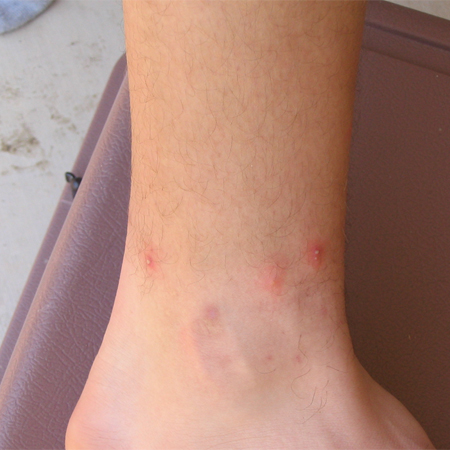
All skin wounds should be assessed for tetanus prophylaxis. Tetanus-prone wounds (deep/dirty/necrotic/severe recluse spider envenomation) should receive tetanus prophylaxis if the last immunization was >5 years ago.[61]Liang JL, Tiwari T, Moro P, et al. Prevention of pertussis, tetanus, and diphtheria with vaccines in the United States: recommendations of the Advisory Committee On Immunization Practices (ACIP). MMWR Recomm Rep. 2018 Apr 27;67(2):1-44.
https://www.ncbi.nlm.nih.gov/pmc/articles/PMC5919600
http://www.ncbi.nlm.nih.gov/pubmed/29702631?tool=bestpractice.com
Nontetanus-prone wounds (e.g., stings/black widow spider bite) should trigger treatment if last immunization was >10 years ago.
Stinger removal
Retained stingers should be removed because they may still contain venom.[Figure caption and citation for the preceding image starts]: Honeybee stinging fleshCourtesy of Rick Vetter [Citation ends].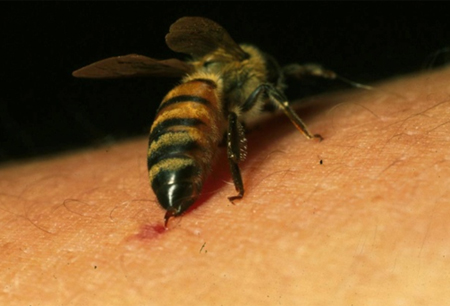
The venom sac is emptied within 30 seconds after exposure; therefore, the stinger should be removed as quickly as possible
Traditional teaching suggests that squeezing the stinger (e.g., with tweezers) can inject more venom into the patient. The stinger should be removed by gently scraping the stinger with the edge of a plastic ID card (e.g., driver's license or similar object). Time to removal is more important than method in minimizing the amount of venom injected.[60]Visscher P, Vetter RS, Camazine S. Removing bee stings. Lancet. 1996 Aug 3;348(9023):301-2.
http://www.ncbi.nlm.nih.gov/pubmed/8709689?tool=bestpractice.com
Corticosteroids
Guidelines vary regarding recommendations for the use of corticosteroids in sting allergy
In practice, many clinicians use oral corticosteroids for large local reactions; however, there is a lack of strong evidence to support the efficacy of this treatment.[32]Golden DB, Demain J, Freeman T, et al. Stinging insect hypersensitivity: a practice parameter update 2016. Ann Allergy Asthma Immunol. 2017 Jan;118(1):28-54.
http://www.ncbi.nlm.nih.gov/pubmed/28007086?tool=bestpractice.com
In severe cases of insect sting reaction there may be a role for a short course of oral corticosteroids.[32]Golden DB, Demain J, Freeman T, et al. Stinging insect hypersensitivity: a practice parameter update 2016. Ann Allergy Asthma Immunol. 2017 Jan;118(1):28-54.
http://www.ncbi.nlm.nih.gov/pubmed/28007086?tool=bestpractice.com
Corticosteroid treatment works in a delayed fashion to decrease vascular permeability and blunt the immune response to the inciting antigen.
H1 antagonists and H2 antagonists
Use of H1 and H2 antagonists is limited to relief of itching, hives, and rhinorrhea.[57]Sheikh A, Ten Broek V, Brown SG, et al. H1-antihistamines for the treatment of anaphylaxis: cochrane systematic review. Allergy. 2007 Aug;62(8):830-7.
https://onlinelibrary.wiley.com/doi/10.1111/j.1398-9995.2007.01435.x
http://www.ncbi.nlm.nih.gov/pubmed/17620060?tool=bestpractice.com
[58]Andreae DA, Andreae MH. Should antihistamines be used to treat anaphylaxis? BMJ. 2009 Jul 10;339:b2489.
http://www.ncbi.nlm.nih.gov/pubmed/19592404?tool=bestpractice.com
Antihistamines antagonize the effects of histamine release at cellular receptors, decreasing itching, erythema, and rash
In general nonsedating H1 antagonists should be used in preference to sedating H1 antagonists, although there may be a role for sedating H1 antagonists at night if symptoms are interrupting sleep.[59]Management of simple insect bites: where's the evidence? Drug Ther Bull. 2012 Apr;50(4):45-8.
http://www.ncbi.nlm.nih.gov/pubmed/22495051?tool=bestpractice.com
H2 antagonists can be used to further potentiate the antihistamine effect, although evidence of benefit is very limited
Topical antihistamines should be avoided as they probably do not add any beneficial effect when patients are already on systemic antihistamines. They can also be irritating to the skin and can lead to contact dermatitis.[59]Management of simple insect bites: where's the evidence? Drug Ther Bull. 2012 Apr;50(4):45-8.
http://www.ncbi.nlm.nih.gov/pubmed/22495051?tool=bestpractice.com
Analgesia
Treatment with acetaminophen or an NSAID can decrease swelling and pain at the site of the bite or sting.[24]Hewett Brumberg EK, Douma MJ, Alibertis K, et al. 2024 American Heart Association and American Red Cross guidelines for first aid. Circulation. 2024 Nov 14.
https://www.ahajournals.org/doi/abs/10.1161/CIR.0000000000001281
http://www.ncbi.nlm.nih.gov/pubmed/39540278?tool=bestpractice.com
[32]Golden DB, Demain J, Freeman T, et al. Stinging insect hypersensitivity: a practice parameter update 2016. Ann Allergy Asthma Immunol. 2017 Jan;118(1):28-54.
http://www.ncbi.nlm.nih.gov/pubmed/28007086?tool=bestpractice.com
These drugs can be tapered by the patient according to their symptoms.
Caution with NSAIDs should be used in patients currently taking aspirin or anticoagulants, patients with sensitivity to these drugs, or patients with risk factors for ulcers, gastrointestinal bleeding, or thromboembolic disease.
Patients with black widow or recluse spider bites may require extra specific treatments (see below).
Black widow spider bites
Most black widow spider bites produce only localized pain at the site of the wound; fatalities are exceedingly rare.[37]Quan D. North American poisonous bites and stings. Crit Care Clin. 2012 Oct;28(4):633-59.
http://www.ncbi.nlm.nih.gov/pubmed/22998994?tool=bestpractice.com
Additional analgesia with opioids may be needed for more severe bites or patients with low pain tolerance.[37]Quan D. North American poisonous bites and stings. Crit Care Clin. 2012 Oct;28(4):633-59.
http://www.ncbi.nlm.nih.gov/pubmed/22998994?tool=bestpractice.com
[Figure caption and citation for the preceding image starts]: Black widow (Latrodectus species); the red hourglass marking is not always this shape and may not be presentCourtesy of Rick Vetter [Citation ends].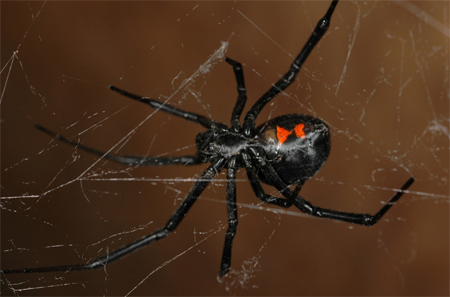 [Figure caption and citation for the preceding image starts]: Black widow (Latrodectus species)Courtesy of Bill Banner [Citation ends].
[Figure caption and citation for the preceding image starts]: Black widow (Latrodectus species)Courtesy of Bill Banner [Citation ends].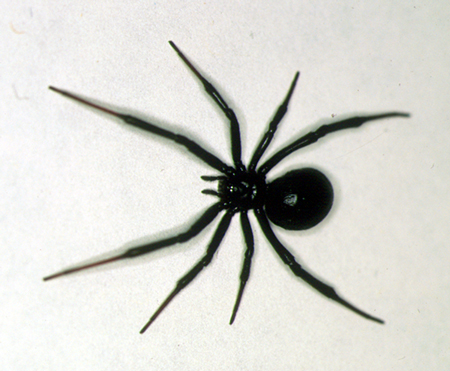
Severe muscle spasms may be relieved with benzodiazepines.[37]Quan D. North American poisonous bites and stings. Crit Care Clin. 2012 Oct;28(4):633-59.
http://www.ncbi.nlm.nih.gov/pubmed/22998994?tool=bestpractice.com
Autonomic instability may lead to profound tachycardia and hypertension. These usually resolve as pain is addressed. In patients who may not tolerate these effects, beta-blockers may be a reasonable treatment.
There are several black widow spider antivenoms available commercially.[62]Isbister GK, Graudins A, White J, et al. Antivenom treatment in arachnidism. J Toxicol Clin Toxicol. 2003;41(3):291-300.
http://www.ncbi.nlm.nih.gov/pubmed/12807312?tool=bestpractice.com
[63]Dart RC, Bogdan G, Heard K, et al. A randomized, double-blind, placebo-controlled trial of a highly purified equine F(ab)2 antibody black widow spider antivenom. Ann Emerg Med. 2013 Apr;61(4):458-67.
http://www.ncbi.nlm.nih.gov/pubmed/23380292?tool=bestpractice.com
Treatment with antivenom has historically been thought to reduce the pain and duration of symptoms. Evidence from randomized controlled trials is mixed: one Australian study showed little (if any) difference between antivenom and placebo; other studies suggest there may be a modest benefit for selected patients, although further evidence is needed.[63]Dart RC, Bogdan G, Heard K, et al. A randomized, double-blind, placebo-controlled trial of a highly purified equine F(ab)2 antibody black widow spider antivenom. Ann Emerg Med. 2013 Apr;61(4):458-67.
http://www.ncbi.nlm.nih.gov/pubmed/23380292?tool=bestpractice.com
[64]Isbister GK, Page CB, Buckley NA, et al; RAVE Investigators. Randomized controlled trial of intravenous antivenom versus placebo for latrodectism: the second Redback Antivenom Evaluation (RAVE-II) study. Ann Emerg Med. 2014 Dec;64(6):620-8.
http://www.ncbi.nlm.nih.gov/pubmed/24999282?tool=bestpractice.com
[65]Dart RC, Bush SP, Heard K, et al. The efficacy of antivenin latrodectus (black widow) equine immune F(ab')₂ versus placebo in the treatment of latrodectism: a randomized, double-blind, placebo-controlled, clinical trial. Ann Emerg Med. 2019 Sep;74(3):439-49.
http://www.ncbi.nlm.nih.gov/pubmed/30926190?tool=bestpractice.com
Indications vary by species, geographic location, and specific symptoms, but may include:[37]Quan D. North American poisonous bites and stings. Crit Care Clin. 2012 Oct;28(4):633-59.
http://www.ncbi.nlm.nih.gov/pubmed/22998994?tool=bestpractice.com
[66]Heard K, O'Malley GF, Dart RC. Antivenom therapy in the Americas. Drugs. 1999 Jul;58(1):5-15.
http://www.ncbi.nlm.nih.gov/pubmed/10439926?tool=bestpractice.com
Continued or severe pain despite aggressive opioid analgesia
Autonomic instability (uncontrolled hypertension)
Respiratory difficulties
Pregnancy
Persistent symptoms despite supportive care.
The decision to use antivenom must include weighing the severity of the symptoms against the safety of antivenom treatment. Although rare, reactions to antivenom can include serum sickness (which manifests as fever, joint pain, and rash) and life-threatening anaphylaxis.[37]Quan D. North American poisonous bites and stings. Crit Care Clin. 2012 Oct;28(4):633-59.
http://www.ncbi.nlm.nih.gov/pubmed/22998994?tool=bestpractice.com
Recluse spider bites
Most Loxosceles species bites can be managed with local wound care.[Figure caption and citation for the preceding image starts]: Brown recluse spider (Loxosceles species); note violin shape darker coloration on cephalothorax and 3 pairs of eyes at the base of the violinCourtesy of Rick Vetter [Citation ends].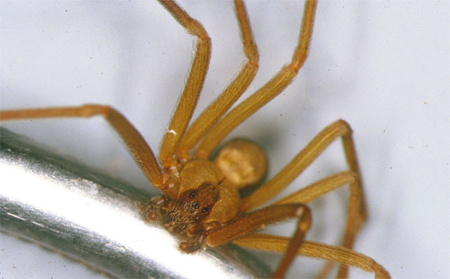 [Figure caption and citation for the preceding image starts]: Brown recluse spider (Loxosceles species)Courtesy of Rick Vetter [Citation ends].
[Figure caption and citation for the preceding image starts]: Brown recluse spider (Loxosceles species)Courtesy of Rick Vetter [Citation ends].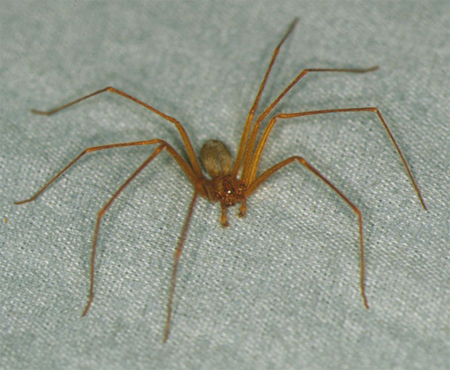 Additional analgesia with opioids may be needed for more severe bites or patients with low pain tolerance.
Additional analgesia with opioids may be needed for more severe bites or patients with low pain tolerance.
Antibiotics are not indicated initially in confirmed bites (although frequently the diagnosis is uncertain and cellulitis is the first differential considered) but should be considered in those with signs or symptoms of infection.[37]Quan D. North American poisonous bites and stings. Crit Care Clin. 2012 Oct;28(4):633-59.
http://www.ncbi.nlm.nih.gov/pubmed/22998994?tool=bestpractice.com
Antibiotic treatment is often started empirically because the diagnosis of spider bite is often unclear, and infections are the other major consideration in the differential diagnosis list. Antibiotic coverage should be appropriate for cellulitis in line with local susceptibility patterns for community-acquired MRSA.
Despite their reputation, only a small number of recluse spider bites become necrotic.[27]Swanson DL, Vetter RS. Bites of brown recluse spiders and suspected necrotic arachnidism. N Engl J Med. 2005 Feb 17;352(7):700-7.
http://www.ncbi.nlm.nih.gov/pubmed/15716564?tool=bestpractice.com
[Figure caption and citation for the preceding image starts]: Lesions from reported brown recluse (Loxosceles species) envenomationCourtesy of Theodore Freeman [Citation ends].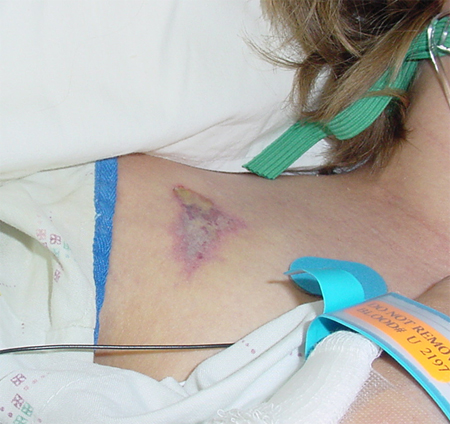 [Figure caption and citation for the preceding image starts]: Lesions from reported brown recluse (Loxosceles species) envenomationCourtesy of Theodore Freeman [Citation ends].
[Figure caption and citation for the preceding image starts]: Lesions from reported brown recluse (Loxosceles species) envenomationCourtesy of Theodore Freeman [Citation ends].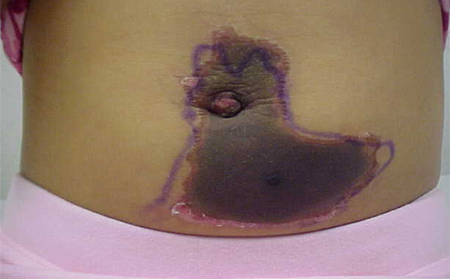 Dapsone has been used to prevent or slow the development of necrosis and reduce pain in necrotic lesions but it should not be used routinely.[37]Quan D. North American poisonous bites and stings. Crit Care Clin. 2012 Oct;28(4):633-59.
http://www.ncbi.nlm.nih.gov/pubmed/22998994?tool=bestpractice.com
No controlled trials have been conducted in humans, and data in animal models have been contradictory.[25]Vetter RS, Isbister GK. Medical aspects of spider bites. Ann Rev Entomol. 2008;53:409-29.
http://www.ncbi.nlm.nih.gov/pubmed/17877450?tool=bestpractice.com
Patients should also be screened for glucose-6-phosphate dehydrogenase deficiency, as dapsone can cause severe hemolytic anemia in these patients. It is not necessary to start dapsone treatment immediately for it to be beneficial, and screening results are usually available within a day.
Dapsone has been used to prevent or slow the development of necrosis and reduce pain in necrotic lesions but it should not be used routinely.[37]Quan D. North American poisonous bites and stings. Crit Care Clin. 2012 Oct;28(4):633-59.
http://www.ncbi.nlm.nih.gov/pubmed/22998994?tool=bestpractice.com
No controlled trials have been conducted in humans, and data in animal models have been contradictory.[25]Vetter RS, Isbister GK. Medical aspects of spider bites. Ann Rev Entomol. 2008;53:409-29.
http://www.ncbi.nlm.nih.gov/pubmed/17877450?tool=bestpractice.com
Patients should also be screened for glucose-6-phosphate dehydrogenase deficiency, as dapsone can cause severe hemolytic anemia in these patients. It is not necessary to start dapsone treatment immediately for it to be beneficial, and screening results are usually available within a day.
Continued necrosis may need surgical debridement and subsequent skin grafting for full healing, although this is a rare occurrence.[37]Quan D. North American poisonous bites and stings. Crit Care Clin. 2012 Oct;28(4):633-59.
http://www.ncbi.nlm.nih.gov/pubmed/22998994?tool=bestpractice.com
Necrotic tissue presents a prime substrate for secondary infection. Patients should be taught appropriate wound care and to be aware of signs of infection (e.g., fever, pus formation).
Antivenoms are available in some South American countries, but not in the US. Some animal studies suggest efficacy at limiting necrosis, but no good human studies are available.[62]Isbister GK, Graudins A, White J, et al. Antivenom treatment in arachnidism. J Toxicol Clin Toxicol. 2003;41(3):291-300.
http://www.ncbi.nlm.nih.gov/pubmed/12807312?tool=bestpractice.com
Secondary infection
Antibiotics should only be prescribed if there are symptoms and signs of infection.[67]National Institute for Health and Care Excellence. Insect bites and stings: antimicrobial prescribing. Sep 2020 [internet publication].
https://www.nice.org.uk/guidance/ng182
Antibiotics should be directed at common skin pathogens (staphylococcal and streptococcal species) and directed by local resistance patterns.
Black widow spider bites do not become necrotic, and antibiotics are not needed unless signs of secondary infection develop over the next few days.


 [Figure caption and citation for the preceding image starts]: Black widow (Latrodectus species)Courtesy of Bill Banner [Citation ends].
[Figure caption and citation for the preceding image starts]: Black widow (Latrodectus species)Courtesy of Bill Banner [Citation ends].
 [Figure caption and citation for the preceding image starts]: Brown recluse spider (Loxosceles species)Courtesy of Rick Vetter [Citation ends].
[Figure caption and citation for the preceding image starts]: Brown recluse spider (Loxosceles species)Courtesy of Rick Vetter [Citation ends]. Additional analgesia with opioids may be needed for more severe bites or patients with low pain tolerance.
Additional analgesia with opioids may be needed for more severe bites or patients with low pain tolerance.  [Figure caption and citation for the preceding image starts]: Lesions from reported brown recluse (Loxosceles species) envenomationCourtesy of Theodore Freeman [Citation ends].
[Figure caption and citation for the preceding image starts]: Lesions from reported brown recluse (Loxosceles species) envenomationCourtesy of Theodore Freeman [Citation ends]. Dapsone has been used to prevent or slow the development of necrosis and reduce pain in necrotic lesions but it should not be used routinely.[37] No controlled trials have been conducted in humans, and data in animal models have been contradictory.[25] Patients should also be screened for glucose-6-phosphate dehydrogenase deficiency, as dapsone can cause severe hemolytic anemia in these patients. It is not necessary to start dapsone treatment immediately for it to be beneficial, and screening results are usually available within a day.
Dapsone has been used to prevent or slow the development of necrosis and reduce pain in necrotic lesions but it should not be used routinely.[37] No controlled trials have been conducted in humans, and data in animal models have been contradictory.[25] Patients should also be screened for glucose-6-phosphate dehydrogenase deficiency, as dapsone can cause severe hemolytic anemia in these patients. It is not necessary to start dapsone treatment immediately for it to be beneficial, and screening results are usually available within a day.